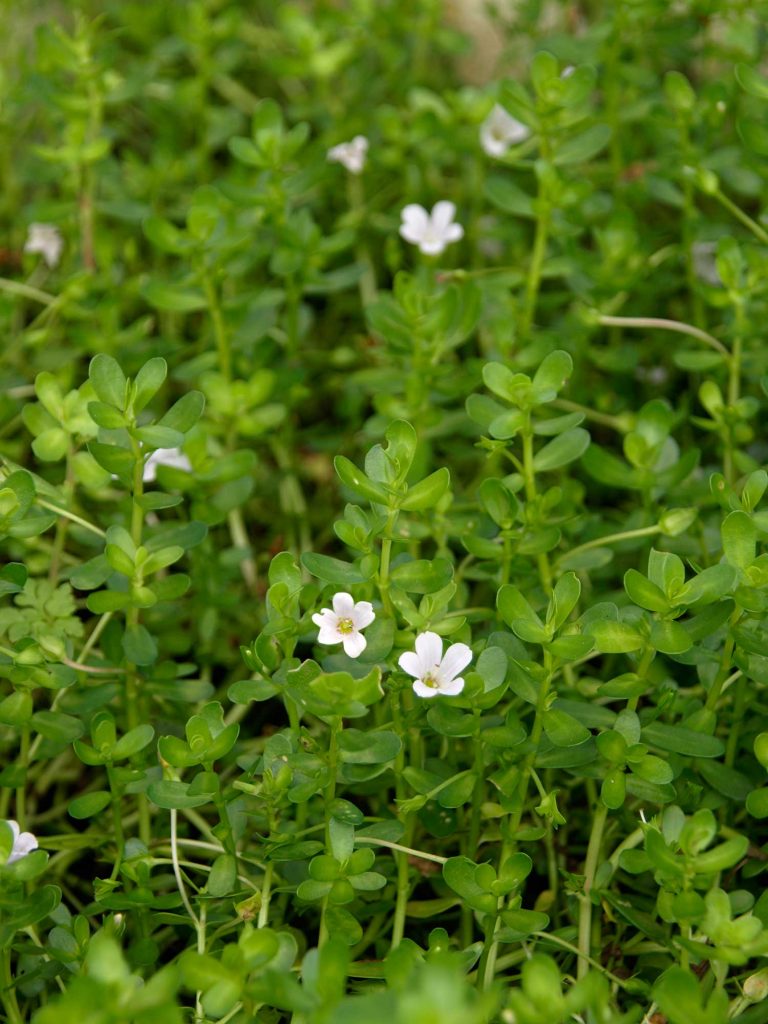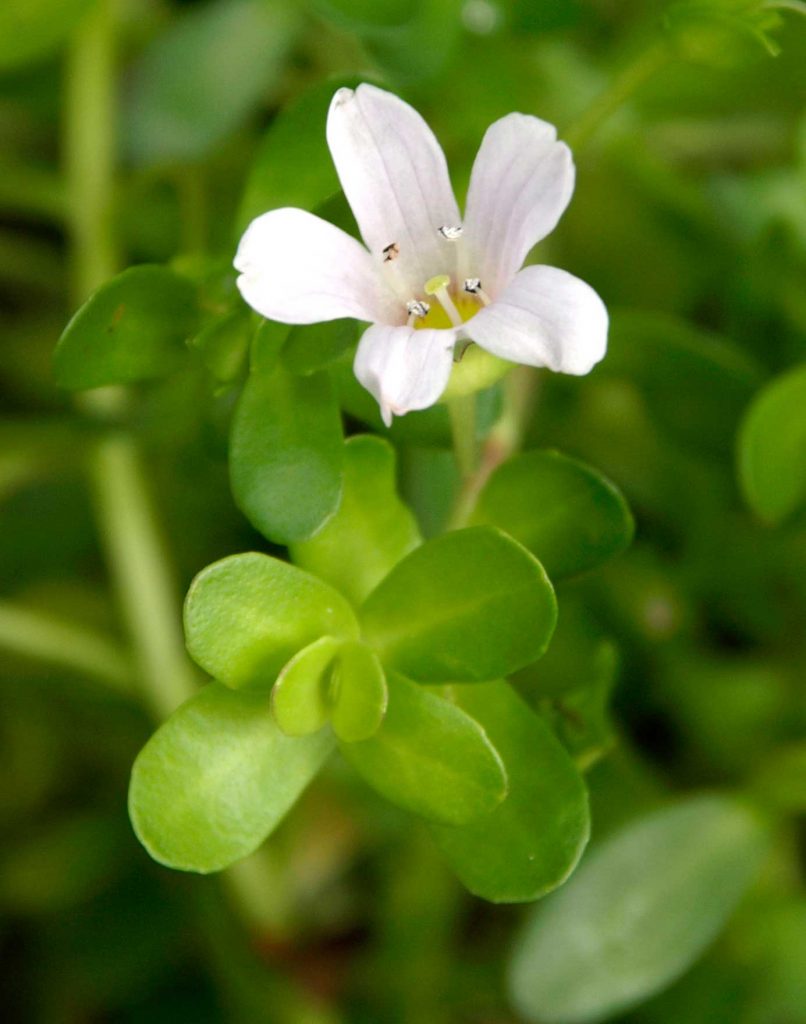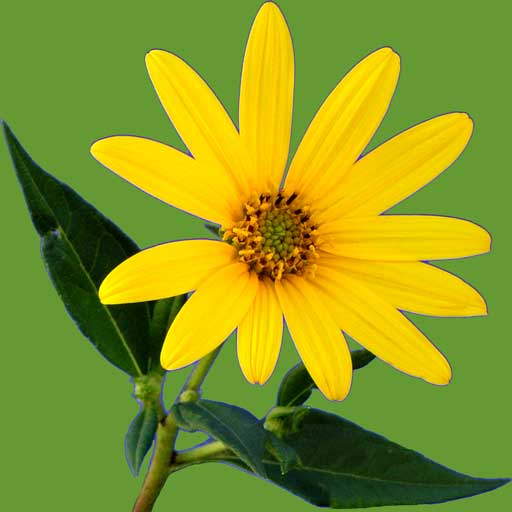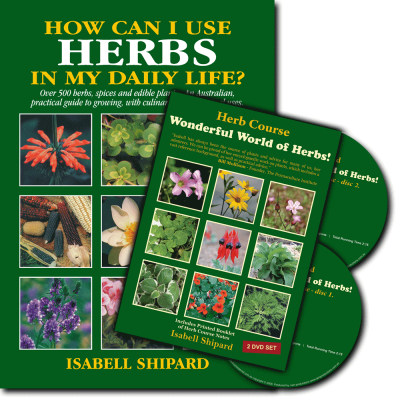Bambhi, Pa-chi-t’ien, Otomeazeni
Bacopa monnieri syn. B. monniera, Monniera cuniefolia, Herpestis monniera F. Scrophulariaceae
Description
Perennial ground cover to 10cm high, with sprawling stems that may root, as they grow along the soil. Fleshy, oval shaped leaves 1-2cm long, form opposite along the stems. Small, tubular, five-petalled, white flowers develop in leaf terminals and can blossom over many months of the year. Small, dark seed set in a flat, oval capsule.

Propagate by seed, cuttings and by root division. Although brahmi is considered a bog plant that likes wet spots, we have found on our herb farm that it will grow in pots, or in the garden in shade, or even full sun (provided ample water is provided in dry spells as it is a shallow rooting plant). Fertilise plants regularly with seaweed or other organic fertiliser. Plants can be grown in hanging pots and as the stems cascade over the sides, they are easily nipped off for use. Brahmi is frost tender and I suggest when grown in cold climates, it could be grown in a large pot or styrofoam box and moved to a warm, sheltered position in winter. Note: brahmi is not Gotu Kola (Centella asiatica) although some reference books may say that gotu kola is called brahmi in Sanskrit. Both brahmi and gotu kola are esteemed Ayurvedic herbs.
… … omitted text, please see How can I use HERBS in my daily life? for full text.
Medicinal Uses
Brahmi has been used in traditional Indian medicine for over 3000 years. It has been used to treat conditions such as: bronchitis, coughs, asthma, hoarseness, arthritis, allergies, rheumatism, inflammatory conditions, fluid retention, backache, chronic skin conditions, high cholesterol levels, constipation, hair loss, boils, ulcers, fevers, digestive problems, epileptic fits, depression including post natal depression, diarrhea, impotence, premature ejaculation, irritable bowel syndrome, frigidity, irregular menstruation, mental and physical fatigue, exhaustion, restlessness, insomnia and over active mind, mental deterioration of the elderly, forgetfulness, confused and cloudy thoughts, anxiety, ADD, stress, hysteria, nervous breakdown, insanity and to improve circulation, strengthen capillaries and stimulate hair, skin and nail growth. Brahmi has been valued as a cardiac, nerve and brain tonic and widely used by students for improving mental clarity, confidence, intelligence, concentration and memory recall. Brahmi as herbal supplements and tablets have been marketed for super learning, for memory and as a brain tonic. In 1963 research on the brahmi plant identified 2 active molecules: Bacoside A that assists in the release of nitric oxide allowing relaxation of the aorta and veins and blood to flow more smoothly through the body and aids circulation; and Bacoside B, a protein valued for nourishing nerve cells in the brain.
In 1993, when the Central Drug Research of India (CDRI) began extensive research of their rich herbal treasures to source active ingredients for modern therapeutic uses, they started clinical trials with brahmi on human volunteers. No adverse effects were recorded. The CDRI presented their research findings to numerous international brain research conferences.
In May 1996 the Royal Society of British Science published a paper on nitric oxide, calling it the marvel of the decade. The article explained that the nitric oxide in brahmi has an extremely positive effect on learning and memory recall, as well as on blood circulation and the function of the liver, lungs and kidneys. Research is also being done on the use of nitric oxide to treat stroke and Alzheimer’s sufferers. In 1998 the Nobel Prize for medicine was awarded to three pharmacologists for their discovery that nitric oxide, in its natural form, has powerful potential as a messenger molecule in the body. A recent scientific study showed that brahmi has potent antioxidant properties, which is, no doubt, why it was also revered in India for strengthening the immune system, improving vitality and performance and promoting longevity. The task of antioxidants in the body is to mop up free radical molecules. A free radical is an unstable chemical fragment, which can cause havoc by damaging DNA, corroding cell membranes and destroying cells.
Free radicals are brought about by many detrimental aspects of modern living … air pollution from car exhausts, smog, cigarette smoke, toxic wastes, pesticides, herbicides, ultra violet light, certain foods and additives, drugs and infections, as well as by daily metabolic functions, including physical activity. Dr Michael Colgan in his book, ‘The new nutrition and antioxidants, all you need to know for sports performance, longevity and prevention of disease’, makes it clear that research shows the value of antioxidants in preventing and even reversing many forms of cancer, heart disease, atherosclerosis, adult diabetes, lung diseases, cataracts and a host of other diseases. All of these diseases, as well as premature aging, are caused by free radical oxidation of healthy tissues. Along with the more familiar antioxidants, Bsitosterol, a powerful fatty acid in brahmi, acts to relieve many degenerative conditions.
Recently, I had the opportunity to attend a Brain Tonics seminar in Brisbane tutored by Dr. S. Ajit, B.A.M.S, P.C.A.S, an Indian holistic physician, who shared his rich background of traditional herbal medicine, including the uses of brahmi, revered to promote intellect, rejuvenate the brain and improve memory. Dr. Ajit stressed the point that rejuvenation must start with the consumption of herbs well before old age. Dose: 3-4g daily. 3g are approximately six sprigs 8-10cm long. The herb is prepared as a tea infusion, or decoction, and sweetened with honey, sugar or stevia leaves if desired. The tincture is made with 60g dried, finely powdered brahmi leaves in 750ml vodka. Take 1 teasp. of the tincture daily.
… … omitted text, please see How can I use HERBS in my daily life? for full text.
Over the last few years I have had some remarkable feedback from people using this plant. People report improved memory, increased levels of energy and an ability to cope better with the stresses of life. A most inspiring example of the use of brahmi was recently shown on TV. A well known rugby player had suffered severe nerve damage. After eight weeks in intensive care and 14 operations, followed by complications and seven and a half months in rehab, he could not walk or talk properly and had no memory retention. The medical verdict was that nothing more could be done. His family would not accept this conclusion, and a loving aunt searched for a cure, which lead her to the CDRI. They told her that brahmi was used for memory enhancement, but had never been used to repair brain damage, and they could not promise results. Her nephew was given brahmi in concentrated extract, and before long his short term memory was back. The TV segment reported he now lives a normal life.
In summary, brahmi can help support and improve all aspects of mental function, including comprehension, memory and ready recall, by enhancing the crucial co-ordination of these three aspects of mental function.





